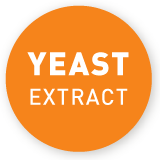Frequently asked questions about yeast extract
Most people living in the UK or Australia will have heard about yeast extract already – it is popular to use it as a spread on sandwiches and toast. In other European countries people do not have a clear understanding of yeast extract – what yeast extract is, its health benefits and how it is used in cooking. We have answered the most frequently asked questions below.
Yeasts are truly a natural all-rounder and are essential for the production of common foods. They occur in nature as wild yeasts everywhere and are grown as culture yeast commercially with specific properties. Fresh yeast has been used for thousands of years to make bread and beer and is also essential for making wine. Yeast extract is also made from fresh yeast. Enzymes break down the proteins that are present in the yeast cell into smaller components and disintegrate the cell wall so that the cell content dissolves. The remaining cell walls are removed by centrifugation. In other words, yeast extract is made up of proteins, peptides, amino acids, carbohydrates, vitamins and minerals from the yeast cell without the surrounding cell wall.
Fresh yeast is the basis of yeast extract. Yeast extract is a natural ingredient composed of a variety of amino acids, peptides, carbohydrates, vitamins and minerals and is rich in high-quality proteins. Although yeast extract is not made up of any animal ingredients, the taste is similar to that of a meat bouillon. This is because many of the same taste–giving amino acids are present in both yeast extract and meat bouillon.
Yeast extract is used in many products available in the supermarket. It is used for instance to improve the flavour of sauces, bouillons, soups, meat and plant-based dishes, ready meals and savoury snacks. In the UK and Australia, it is common to put a savoury yeast extract spread on toast and sandwiches. In other countries yeast extract is available for consumers in supermarkets and organic food shops.
Yes, yeast extract is a natural ingredient derived from fresh yeast by using traditional methods including fermentation. No non-natural ingredients are added.
Yeast extract has been used as an ingredient in food products since the early 20th century. However, the basic ingredient for yeast extract, fresh yeast, has been used for thousands of years to make bread and beer. Combining ingredients and influencing taste is what cooking is all about. Yeast extract not only adds taste, but also brings out and balances flavours in products, just like herbs and spices do. That’s why today, yeast extract is a very popular ingredient.
Yes. Even though it provides a meaty taste to food, yeast extract does not contain ingredients from animal origin and is therefore suitable for vegetarian and vegan dishes. Read more …
The yeast cell, and therefore yeast extract, inherently does not contain gluten. For some yeast extracts the gluten-free status may change due to the ingredients used during fermentation.
The easiest way for consumers to check whether a yeast extract is gluten-free is through the specific gluten free labels on the packaging.
Yeast extract contains around 65% of protein. Its origin, natural yeast, is composed of a rich mix of proteins and amino acids that are also found in yeast extract. The protein quality of yeast extract is comparable to eggs or milk, but with no animal components.
Thanks to its rich mix of protein compounds, yeast extract has an aromatic taste of its own. This brings a delicious, savoury note to foods, even those with a low salt content. It intensifies the salt perception due to its umami taste. Nutritional experts advise a similar approach when they recommend using aromatic herbs in order to use less salt in the kitchen.
No, nutritional yeast contains whole yeast cells, while yeast extract only contains the dissolved parts of the yeast cells.
Yeast extract contains many amino acids including glutamic acid and thereby it is one of the many natural components of yeast extract coming from fresh yeast. Many other foods naturally contain glutamic acid, including tomatoes, parmesan cheese, peas and mushrooms. Our body also produces glutamic acid, regardless of the food we consume, it is naturally present in saliva and breast milk.
In comparison with other foods, we consume daily – including tomatoes, mushrooms and cheese – the glutamic acid level of yeast extract is low. For instance, one tomato contains on average approximately twice the amount of glutamic acid present in 200ml of bouillon containing yeast extract.
No, yeast extract is not a flavour enhancer. It is a natural ingredient which contains 20 amino acids, among which we find glutamic acid, also present in many other foods, such as tomatoes or cheese. It contributes to savoury taste. Yeast extract is added to food to impart flavour and meets the definition of ‘flavouring preparation’ (EU) and ‘natural flavor’ (USA). This is not to be confused with monosodium glutamate (MSG), which is purified 100% sodium salt of glutamate, and under EU and US regulations must be declared as an additive. Different to yeast extract, MSG has very little taste and is only used to enhance the existing flavour.
Yeast extract, used with a primary function of flavouring in foods, can be labelled as “yeast extract” or “natural flavouring” in the list of ingredients. If yeast extract is added to food for nutritional purposes, then “yeast extract” is a generally accepted customary name that can be included in the list of ingredients. Read more on food labelling.
As yeast extract has an aromatic taste of its own, it is used only in small quantities – just like other seasoning ingredients. The concentration of yeast extract in dishes is typically less than1%.
Yes! Yeast extract is manufactured from fresh yeast by using traditional production methods. Global regulatory bodies consider yeast extract as a safe food ingredient.




